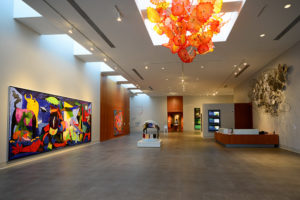By Tom Travis
“The arts have meant a lot in terms of transforming my life. I grew up in the southwest Detroit, immigrant neighborhood — mostly Italians, in the shadow of the Ford Rouge Plant. A lot of people that lived in my neighborhood worked at Ford or for Marathon Oil or one of the other industries in the area. So it was a very hard working, working-class, blue collar neighborhood.
That significant background is part of what motivates and has prepared Tracee Glab for her job as the newly-selected executive director of the Flint Institute of Arts (FIA).

New Director of The Flint Institute of Arts, Tracee Glaab. (Photo source: FIA)
“The arts weren’t really a part of our everyday life. Survival was, to be honest,” she recalls. “But as a kid I had my first visit to the Detroit Institute of Arts (DIA) and when I was exposed to it through high school and college it opened up a whole new world for me,”
Glab spoke with EVM in the stately, wood paneled LaFleur library of the FIA. She replaces previous FIA Executive Director John Henry who had served as FIA’s executive director for 24 years.

LeFleur Library at the FIA. (Photo by Tom Travis)
“What’s next? What do we do with all this?”
“We have this amazing jewel in the community and we’re building on a very firm foundation with the fabulous collection and wonderful building, an art school that is top-notch with wonderful instructors so my thought is, ‘What’s next? What do we do with all this?'” she says.
Glab says the answer is two-fold: one, getting the word out to people in the community, including the Genesee County area and all of southeast Michigan because the FIA and its adjacent neighbors in the Flint Cultural Center are a close driving distance for most communities.
“To have this resource where you can go to an art museum and a science history museum in one visit and including the planetarium, there really isn’t anything like that in Michigan,” she notes.
Kearsley Street entrance to FIA. (Photo source: FIA)
“The second thing is I want more ownership,” she says. “I want our visitors that are already coming as well as people who haven’t been here to really feel like this is their museum, that it’s not someone else’s, that they have some ownership in it.
“That takes building trust, building bridges with community members. We have been doing that: that’s not something brand new I’m bringing, but I want to further it. I want to explore ways to discover ways we haven’t tried or maybe things we tried five or ten years ago that didn’t work then but maybe it would now because things are different.”
Reflecting on the recent updates in the Cultural Center, Glab says, “It’s growing and changing…I think it’s an exciting time to be the director of the FIA because with newly renovated Flint Public Library (FPL) and Sloan Museum of Discovery. I think the Cultural Center is going to get a lot more visitors than we normally do.”
Glab said she has seen the number of visitors rise already, especially on Saturdays, as people visit the Cultural Center’s newest update, The Sloan Museum of Discovery.
Public invited to an Open House Saturday, Sept 10
Glab says she is looking forward to meeting the community and listening to their questions and comments at an open house scheduled for 12 noon to 2 p.m. Saturday, Sept. 10. Glab will meet visitors in the Bray Gallery where they will have a chance to chat with her and learn about her vision for the FIA.
FIA, one of the largest art museum schools in the U.S.
Glab steps into the top spot at an institution with a long history. For more than 90 years the FIA has been a fixture in the Flint community. Established in 1928 before moving to the present location in Flint’s Cultural Center on Kearsley Street the FIA now hails as the second largest art museum in the State of Michigan and one of the largest art museum schools in the nation. Over the years the gallery has amassed an art collection with over 8,500 objects with some spanning back 5,000 years. Most of the art objects at FIA are European and American paintings, according to FIA’s website.

Flint Institute of Arts south entrance. (Photo by Tom Travis)
The FIA houses 25 galleries, a sculpture courtyard and 15 art studio spaces in its 175,000 square feet. The FIA boasts 160,000 annual visitors and about 2,200 students from preschool to adult who take classes each year, according to the FIA website.
“I can’t do this alone”
Glab says she realizes she’s the leader, but “I can’t do this alone. I’m counting on my team, I have a great staff here. And I’m counting on community members and people who have supported the museum and maybe people who haven’t yet supported the museum but want to. This is the only way we can take on this huge task, that word of mouth.
“We can invest lots of money in marketing, but it doesn’t replace the power of the word-of-mouth advertising.” she asserts. The FIA employs about 98 and is governed by a 29-member board, according to FIA’s guidestar.com report. The FIA has more than 90 employees and 7 senior staff with a racial make-up of 77 per cent white and 31 per cent Black/African-American, according to the guidestar.com report, along with a nearly 50 per cent ratio for male and female.
FIA Board chose Glab from a list of 144 candidates
FIA Board President, Tom Lillie said the Mark Oppenheimer firm was hired to initiate the nation-wide search for a new executive director. Oppenheimer returned a list with 144 names to the FIA board. An executive committee of nine-FIA board members met to go over the 144 names. With the help of Oppenheimer and the FIA executive committee they chose 12 candidates. The whole FIA board examined the names and applications of the 12-candidates and narrowed the list to three.
Of the three, Glab, the FIA’s curator, was the only local candidate. One candidate was from Kansas City and the other was from Massachusetts. Most of the executive committee meetings were held over Zoom. The interviews of the final three candidates were held in-person in the homes of various FIA board members.
Lillie explained that for each of the three candidates an extensive tour was given of the Cultural Center’s buildings and institutions, housing options in Flint and Genesee County and local points of interest in the area. Lillie commented that each of the candidates were “blown away” by the extent and beauty of the Cultural Center.
Glab came to the FIA fourteen years ago, 2009, starting as an associate curator, then moved on to being the curator of collections and exhibitions. Her first project at the FIA was working on a Bray Gallery project. Glab has a B.A. from the University of Michigan-Dearborn and an M.A. in Art History with a study focus in museum studies from Wayne State University.
“We’re trying to reach people at multiple levels.”
“There’s a lot of work to be done and I’m the first to admit that,” Glab says. “And I realize that really good ideas can often come from outside the museum. As a leader, the director, my mission is to listen to people and there are already ideals out there that important to listen to. Sometimes we can’t execute them all for a variety of reasons, financial, staffing etc.
“It’s also important for me to be in tune with what’s going on in the museum world and other changes that are happening across the country to better understand where the future of museums are. We are definitely in period of change; we can’t stay the same the way we always have because everyone else has,” Glab says.

(FIA logo, FIA website)
The FIA offers specially designed tours of the galleries for those who suffer from memory loss. Those who use wheelchairs or walkers are invited to tour the galleries, according to their website. Tours and programs are offered for Homeschool programs. The Fall 2022 catalogue of classes can be viewed at this link.
“If COVID taught us anything, it taught us that our outreach isn’t just in-person — it’s also digitally and using tools like video and the internet to make our presence known in our community and around the world,” Glab says.
A link for registration in FIA classes and workshops can be found on their website and here.
“…More accessibility and more ways to connect to our community…”
Glab envisions for the future of FIA a hope to continue “the same standards, excellence in programs and offerings of exhibitions.” She says she hopes to see “more accessibility” for Flint residents and, “more ways that we can connect to our community and have the community connect to us, so it’s a two-way street.
“We’re a passive place, meaning, we’re here and we’re open,” she says,” But I want to explore ways that we can reach out. I understand we are doing that but I feel like there are more ways, more creative ways but I am going to explore this with our team more. I would like to see how we can be in the neighborhoods more.”
Memberships for area teachers available
Recently a sponsor come forward and offered to pay for a free membership for any teacher in Genesee County who wants to have a FIA membership. Glab explains. “It helps the teachers to know what we have in our collection and what we offer here. Hopefully they will be inspired to bring their students to the FIA or at least talk to their students about what is offered.”
“The milage has affected us very positively”
Thanks to a 2018 milage approval, everyday Genesee County residents can come to the FIA for free. In 2018, voters passed an Arts Education and Cultural Enrichment millage by 47 percent “yes” to 43 percent “no.”
“The milage has affected us very positively” Glab says. ” It has enabled us to offer the educational programs that we have, exhibitions and collections, in addition to staying open and being available our residents now get in free. The milage funding has helped us to be able to cover the key areas of staying open and available for our community,” said Glab.
“The milage passage made us aware of the community’s desire to support the arts and art culture, it’s not just the FIA but a whole range of institutions including the Greater Flint Arts Council, Berston Field House, Flint Institute of Music and the Sloan Museum of Discovery,” she explains.
“How I see it is that the people who are supporting the milage are investing in the community for the future.”
One of the number one things that makes a place desirable to live in, along with good schools and safety, is arts and culture, she adds.

Flint Institute of Arts (Photo source: FIA)
“Having the arts in peoples’ lives makes them better people, makes them better humans, makes them more sensitive, more empathetic. Even if they don’t choose arts as their career, the arts make people more tender. For example, there are art museums using art programs to reach out to people who haven’t had those kinds of experience before and looking at ways the arts can impact their lives. My focus is how can the FIA have an impact here and see how we answer that.
“I’d love to see the gallery filled with people. COVID had a devastating effect on our attendance but we’re coming back from that. I keep repeating this but I’m really passionate about wanting the people of the community to feel like it’s their gallery,” Glab says.
“I felt like this is where I would do the most good. I really loved my job as curator and I was reluctant to leave it because I love being a curator. But I felt like this was the natural step in my career and I really love Flint and I wanted to set down roots here.”
Glab isn’t sure how this new position is going to change her life but added, “it already has changed my life, in that people are talking to me in a different way. I’m getting an opportunity to talk to more peer-to-peer conversations that I didn’t have before as curator, and more discussions with the other directors in the Cultural Center, so that is one way my life has changed in that it is much more opened up to other people in the community that I didn’t necessarily have access to because I was a curator but now the director.
“Ask me about it in another year,” she says. “This change has been a whirlwind and I’m not exactly sure how everything is going to change.”
Art galleries can have a perceived image of elitism
EVM suggested to Glab sometimes museums and art galleries can have a perceived image of being elitist or only for the rich.
Glab responded, “I’ve not heard that but I would love to have a conversation with anyone who thinks that. I can understand why historically museums have had that elitist vibe. Rich people gave objects of art and gave money so it became a rich person’s palace. But I think if people who said that met me and talked with me I could hopefully change their mind.
“While FIA still needs, very much, the wealthy to support us, from my experience, with our donors here they all agree and are passionate about making everything in our collection accessible to everyone. That says a lot to me, it says that our supporters and donors will step up and make sure we have greater accessibility for our community.
“We are going through a moment of deep reflection,’ she says. “We’re starting to look at things that have a deep root in white supremacist ideas. The idea that one culture can appropriate another culture, put it on view and put it in a case — all museums are grappling with that and the only way we can really grapple with is to be honest about it.
“While we are being honest about it we also need to be good listeners and see how those practices have hurt people in the past. How have past practices made people feel excluded?” she explains.
“We’re listening to the community to see what they want.” Glab
“I wish we could just wave a magic wand and make all of it go away, but I know that’s not possible. But I do think it’s possible that we get there, eventually. I want to take steps to get there. So we’re listening to the community to see what they want. Because I don’t want to assume that I know the way or I know how to make feel more comfortable. I want to hear from other people.
“I’m hopeful they can be honest with me and let me know, ‘this is why I felt excluded.’ And maybe it’s not just about admission — it’s something else. Maybe when they walk through the door it’s not comfortable for them and I don’t know what that is until I hear from people. So I definitely want people to come up to me and tell me those things because maybe it’s something we can work on and address.
“Every community is different and what works in one community may not work here. So that’s where I’m really relying on people to work with me. And I really want to change that perception [that the gallery is for the rich] because I don’t like that perception,” she states.
Glab presently lives in Oak Park with her husband and two dogs, Higgins, a lab; and Cody, a Pomeranian. But she added that she made an offer on a house in Flint the day of the interview with EVM.

Art workshops and courses are offered year-round to the community. (Photo source: FIA)
Glab admits she is not an artist herself but is a student of art. Glab does hail as a writer and is currently focusing on writing about museum work. She has also written art historical essays for exhibition catalogues. She has written fiction and claims to love words and storytelling, “for me, art is just another form of storytelling.”
Glab says that early on in her career she was drawn to 19th-century British art. but because of the collection at The FIA, which is primarily American, European and contemporary, she’s changed her focus.
“I’m a generalist – one day I may be working on Chinese art and the next day on American 20th century paintings. I love it because it makes things more interesting and I like to look at connections and themes between objects rather than just focus on one area. I have done the most research on paintings, but am drawn to all forms of art.”
Flint As Family exhibition coming to FIA this Fall
This Fall the FIA will offer an exhibit called Flint As Family in three acts and about the Flint Water Crisis. The opening for the exhibition is planned to be a reception and panel discussion with the participants of the project as well as the artist who took the photos.
EVM Managing Editor Tom Travis can be reached at tomntravis@gmail.com



You must be logged in to post a comment.